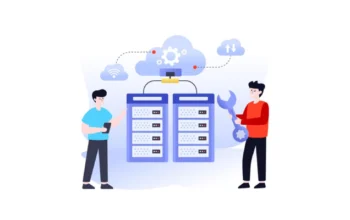Effective 24×7 NOC monitoring hinges on several key features working together. Proactive network monitoring ensures real-time checks on routers, servers, and cloud systems to catch issues early using AI-driven alerts. Round-the-clock technical support offers immediate assistance through various channels with clear escalation paths for complex problems. Incident, problem, and change management follow structured workflows to resolve and prevent issues efficiently. Network device management tracks hardware health and applies patches regularly for security. Strong security measures protect endpoints and networks while collaborating with SOC teams. Comprehensive documentation aids troubleshooting, while reporting delivers insights for continuous improvement. Together, these elements help maintain reliable network performance with minimal downtime.
Proactive Network Monitoring with Real-Time Alerts
Effective 24×7 NOC monitoring relies heavily on proactive network monitoring that continuously observes every part of the infrastructure, from routers, switches, and servers to applications, websites, and cloud platforms. This comprehensive coverage collects detailed telemetry data, including key performance indicators like latency, packet loss, CPU and memory usage, response times, and uptime. By leveraging AI and machine learning, the system analyzes this data to detect early warning signs of potential problems before they impact users. Automated alert systems trigger notifications as soon as any metric crosses predefined thresholds, allowing NOC teams to respond quickly and prevent downtime. To ensure service quality, user experience is also monitored by simulating typical workflows, which helps identify service degradation early. Alerts are prioritized based on their impact and severity so that attention is focused where it matters most. This monitoring extends to both physical hardware and virtual components, providing full visibility across the entire network environment. Historical data trends further support identifying patterns that could lead to future issues. Integration with other management tools creates a centralized platform for monitoring and incident response, shifting network operations from reactive firefighting to preventive maintenance. For example, if CPU usage spikes on a critical server, the system can alert the NOC immediately, enabling swift action before users notice any slowdown.
- Continuous monitoring covers routers, switches, servers, applications, websites, and cloud platforms to track network health.
- Telemetry gathers key performance indicators like latency, packet loss, CPU and memory usage, response times, and uptime.
- AI and machine learning analyze data to spot early warning signs before issues affect users.
- Alert systems trigger notifications automatically when metrics cross set thresholds, enabling quick reaction.
- User experience is assessed by simulating workflows to detect service degradation.
- Alerts are prioritized based on impact and severity to focus attention effectively.
- Monitoring includes both physical and virtual infrastructure components for full coverage.
- Historical data trends help identify patterns that may indicate future problems.
- Integration with other management tools allows centralized monitoring and response.
24/7 Technical Support and Helpdesk Services
Effective 24/7 NOC monitoring depends heavily on continuous technical support and helpdesk services. Skilled support staff are available around the clock to promptly address network and system issues, minimizing downtime. Users can report problems through multiple channels, such as phone, email, and chat, making it easy to get help when needed. Tickets submitted are automatically categorized and routed to the right teams, ensuring faster initial responses and streamlined issue handling. Service level agreements (SLAs) set clear expectations for resolution times to keep disruptions as brief as possible. A tiered support model allows routine issues to be handled quickly while escalating complex problems to specialized engineers without delay. Helpdesk software tracks technician performance and support quality, enabling ongoing improvements through targeted training that fills knowledge gaps. Remote troubleshooting capabilities help reduce costly on-site visits, speeding up issue resolution and lowering operational expenses. Comprehensive knowledge bases provide both users and technicians quick access to proven solutions, improving first-contact resolution rates. Support teams monitor key metrics like average resolution time and first contact resolution to optimize workflows and maintain high service standards throughout all hours.
Incident, Problem, and Change Management Workflows
Effective 24×7 NOC monitoring relies heavily on well-defined incident, problem, and change management workflows. Incidents are logged meticulously, capturing detailed information from initial detection through resolution and root cause analysis. This ensures that every event is tracked and prioritized based on severity and impact, allowing resources to be allocated where they matter most. Critical issues receive immediate attention through established escalation procedures and on-call rotations, minimizing downtime and preventing cascading failures. Problem management extends beyond individual incidents by investigating recurring or complex issues to identify permanent solutions, reducing the risk of repeated disruptions. Change management is governed by a formal approval process involving a Change Advisory Board, which reviews and schedules changes with clear rollback plans to enable quick recovery if needed. All actions related to incidents and changes are documented thoroughly, supporting audit requirements and preserving organizational knowledge. These processes follow ITIL standards, promoting consistency and operational efficiency. Clear communication protocols keep stakeholders informed throughout the incident lifecycle and during changes, maintaining transparency and trust. Regular workflow reviews help refine response strategies, ensuring continuous improvement in incident and change handling. For example, a network upgrade would pass through CAB approval with a tested rollback plan in place, while a persistent connectivity issue would trigger a problem management investigation to find a lasting fix, demonstrating the practical application of these workflows.
Comprehensive Network Device Management
Effective 24×7 NOC monitoring involves managing all critical network devices such as routers, switches, firewalls, load balancers, and wireless access points. Monitoring device health includes tracking firmware status, configurations, and performance metrics to spot issues early. Regularly applying security patches and firmware updates helps maintain device integrity and reduces vulnerabilities. Keeping an accurate inventory and capacity records ensures the network can handle growth without running out of resources like ports or bandwidth. Configuration audits verify that devices comply with security policies and eliminate unused services that might expose risks. Detailed topology maps and documentation make troubleshooting and managing changes smoother, while backup configurations enable quick recovery when problems arise. Optimizing network parameters reduces latency and improves traffic flow, enhancing overall performance. Additionally, automated alerts notify NOC teams of device malfunctions or configuration drifts, allowing timely intervention. Lifecycle management plans for upgrades and replacements keep the infrastructure reliable and up to date, preventing unexpected failures and downtime.
Multi-Layered Security Management
Effective 24×7 NOC monitoring relies on a multi-layered security approach that covers endpoints, servers, and the network perimeter. Endpoint protection includes antivirus deployment, timely patching, and quarantine protocols to stop threats before they spread. Servers are hardened through configuration management, ongoing certificate monitoring, and enforcing least privilege access to limit exposure. Network perimeter defenses use firewalls, intrusion prevention systems, and wireless protections to block unauthorized access and identify malicious activity early. These security tools connect with SIEM platforms and work alongside SOC teams, enabling continuous threat detection and coordinated incident response. Regular reviews of security policies, vulnerability scans, and configuration audits help reduce attack surfaces and maintain compliance with standards. Proactive identification of anomalous traffic and cyber threats allows for swift mitigation before issues escalate. Access controls and monitoring prevent unauthorized use of network resources, supported by clear incident response plans ready to address breaches or suspicious behavior. Additionally, ongoing staff training and awareness programs reinforce security best practices, ensuring the human element stays alert and informed. Together, these layers create a strong, resilient defense that supports uninterrupted network operations and rapid recovery when needed.
Accurate Network Diagrams and Documentation
Effective 24×7 NOC monitoring relies heavily on maintaining accurate network diagrams and thorough documentation. High-level and detailed diagrams provide clear views of physical and logical connections across all network segments, including branches, data centers, cloud environments, and third-party links. These visuals help NOC teams quickly understand network topology, speeding up troubleshooting and enabling smoother network changes. Comprehensive inventories list all devices, applications, and configuration details, giving a complete picture of the network’s components and their current status. Operational procedures, runbooks, and emergency protocols are carefully documented and stored in a centralized repository with controlled access. This centralization ensures consistency and serves as a single source of truth for the team. Keeping documentation up to date, with clear labeling and version control, reduces errors and avoids confusion during shift handoffs or personnel changes. Change logs track every modification, supporting audit requirements and providing transparency in network management. Beyond daily operations, detailed documentation supports business continuity plans by capturing critical network information that minimizes downtime during emergencies or staff absences. Overall, well-maintained network diagrams and documentation help preserve institutional knowledge, reducing reliance on individual expertise and enabling the NOC to operate efficiently around the clock.
Detailed Reporting and Analytics for Decision Making
Effective 24×7 NOC monitoring relies heavily on detailed reporting and analytics to guide informed decisions and continuous improvement. Reports typically cover network utilization, traffic patterns, application performance, and capacity trends, providing a clear picture of how resources are being used and where bottlenecks may occur. Incident reports dig deeper by analyzing root causes, resolution times, and downtime impacts, helping teams refine processes to reduce future disruptions. Security analytics play a crucial role by highlighting suspicious activities and tracking compliance with established policies, which is essential for maintaining a strong security posture. Helpdesk metrics such as mean time to repair and SLA adherence are tracked to evaluate support efficiency and identify areas for staff training or process optimization. Capacity planning reports help forecast infrastructure needs, ensuring upgrades and resource allocation align with business growth and avoid unexpected constraints. Executive dashboards offer high-level views of network health and operational effectiveness, making it easier for leadership to understand performance without getting lost in technical details. Customizable reports serve both technical teams and management, catering to their unique needs and facilitating collaboration. Regular review of these reports supports proactive trend analysis, allowing emerging issues to be identified and resolved before they escalate. By turning raw data into actionable insights, NOC teams can align network operations with broader business goals, ensuring technology supports organizational success.
Frequently Asked Questions
1. How does real-time alerting improve the efficiency of 24×7 NOC monitoring?
Real-time alerting ensures that network issues are detected and reported immediately, allowing the NOC team to respond quickly before small problems escalate into major outages. This minimizes downtime and helps maintain consistent service performance.
2. Why is scalability an important feature in effective 24×7 NOC monitoring services?
Scalability allows the NOC system to handle growing network demands without losing performance or monitoring capabilities. As businesses expand their IT infrastructure, scalable monitoring ensures all new devices and services are covered without interruption.
3. What role does proactive issue detection play in 24×7 NOC monitoring?
Proactive issue detection means identifying potential problems before they affect users or systems. This helps NOC teams fix vulnerabilities or bottlenecks early, reducing the risk of outages and improving overall network reliability.
4. How does comprehensive reporting contribute to the effectiveness of NOC monitoring?
Comprehensive reporting provides detailed insights into network performance, trends, and incidents. These reports enable IT leaders to make informed decisions, optimize infrastructure, and plan maintenance more effectively, all of which are essential for maintaining smooth operations.
5. In what ways does integrating automation enhance 24×7 NOC monitoring?
Automation helps streamline repetitive monitoring tasks, such as routine checks and incident responses, which reduces human error and speeds up problem resolution. It allows the NOC team to focus on complex issues while improving overall efficiency and consistency in network management.
TL;DR Effective 24×7 NOC monitoring hinges on seven key features: proactive real-time network monitoring with alerts to catch issues early, around-the-clock technical support for quick problem resolution, structured incident and change management, and thorough network device management. Security is multi-layered, covering endpoints to network perimeters, integrated with SIEM and SOC collaboration. Up-to-date network diagrams and documentation support efficient operations and troubleshooting. Detailed reporting and analytics enable data-driven decisions to optimize performance. Together, these elements ensure high availability, better user experience, improved security, and solid business continuity in a connected world.




